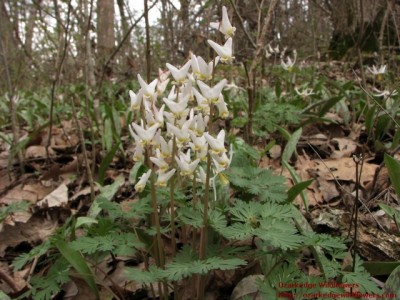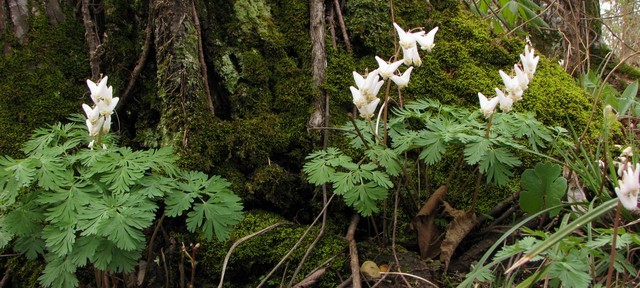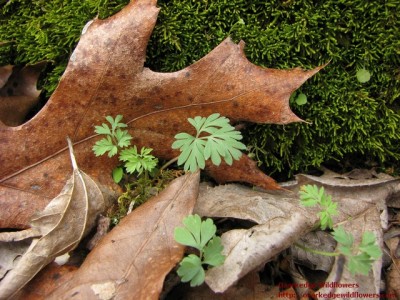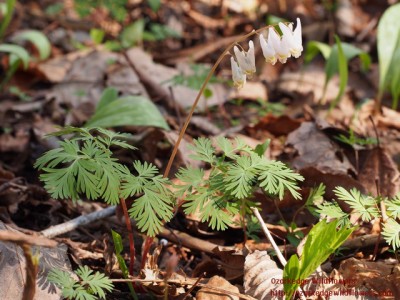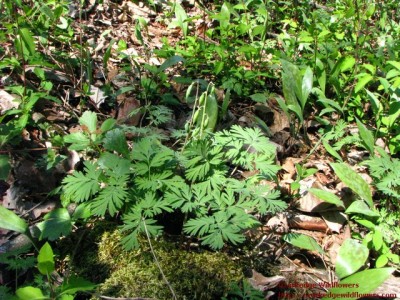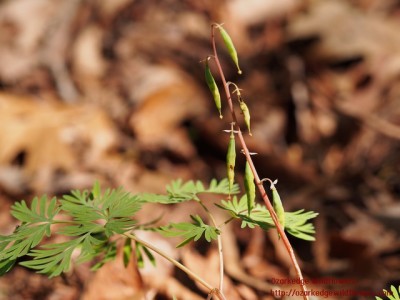Dutchman’s Breeches have to be right up at the top of the list of interesting wildflowers. Their fascinating bloom really looks like a row of pantaloons hung out to dry. I remember reading about these plants as a young girl and thinking that they seemed magical and not real at all. You can imagine how amazed I was when I first discovered them blooming on Ozarkedge a few springs ago. What a lucky break to be out hiking during their bloom time. I nearly stepped on them, but knew right away what a treasure I’d found. Now I know just where and when to find them. And this year- I’ve found even more of their favorite places.
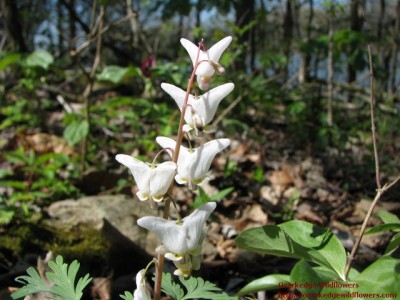 Dicentra cucullaria in peak bloom
Dicentra cucullaria in peak bloom
Latin name/Common name- The Latin name is Dicentra cucullaria. The Dicentra familiy includes Bleeding Heart (Dicentra eximia) and Squirrel Corn (Dicentra canadensis). I haven’t found either of them at Ozarkedge. But if you have seen them, you will notice the similarity between them all in the shape of the leaf and bloom.
Bloom Color- The pantaloons on the Dutchman’ s Breeches are a gentle white with a bit of pale yellow near what would be the waist of the pantaloons or breeches. Take a look at this close-up of the blooms.
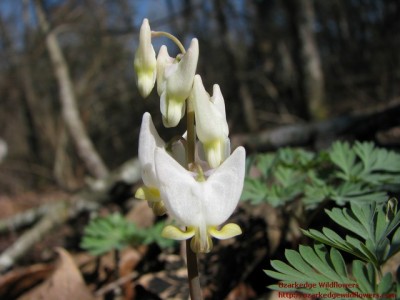 Soft white blooms with a hint of yellow
Soft white blooms with a hint of yellow
Description- Seeing Dutchman’s Breeches in bloom in their natural setting is a rare treat. The foliage is a beautiful blue-green color and has a fern-like appearance. The leaves lie close to the ground (maybe 6 or 7 inches) and make a nice contrast against the rocks and brown leaves on the woodland floor.
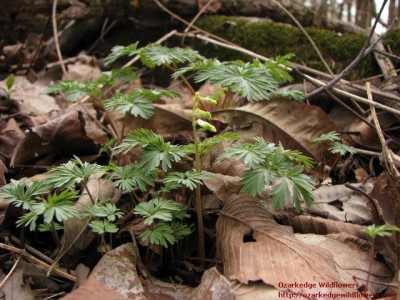 Blue-green foliage is lovely against last season’s brown leaves
Blue-green foliage is lovely against last season’s brown leaves
When the plant is ready to bloom, a stalk will be seen protruding above the foliage. The immature flower are slightly beige and whiten up as they fully bloom.
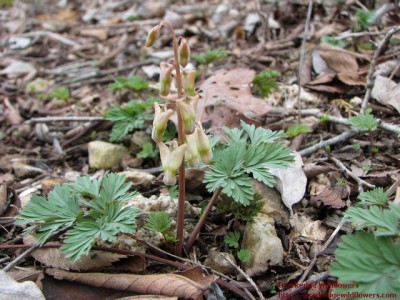 Single stalk with flower buds mid March
Single stalk with flower buds mid March
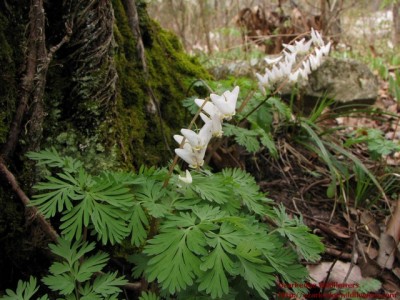 I’ve seen anywhere from about 4 to 10 flowers on a stalk
I’ve seen anywhere from about 4 to 10 flowers on a stalk
Plants with single leaves are immature and aren’t ready to bloom this year.
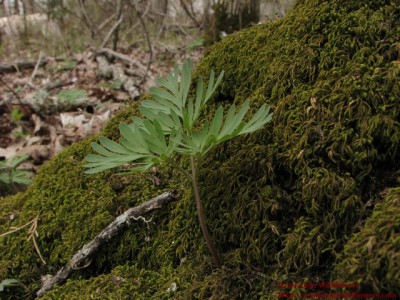 Immature plant with single leaf
Immature plant with single leaf
Bloom-time- Dutchman’s Breeches start blooming in mid March on Ozarkedge. I find them blooming at the same time as Bloodroot and Rue Anenome, but just before the Trout Lillies and Trilliums. A very similar looking plant with yellow blooms is the Pale Corydalis. It’s bloom time overlaps Dutchman’s Breeches, but the peak is later.
Dicentra cucullaria is a spring ephemeral, so after it blooms and develops seed pods, the leaves turn yellow and wither.
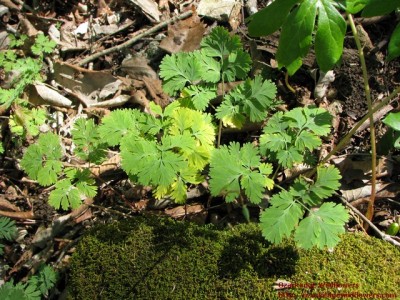 Mid april leaves start to yellow and by May the plant disappears back into the soil
Mid april leaves start to yellow and by May the plant disappears back into the soil
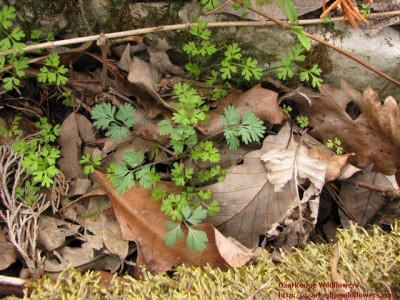 Leaves of Dutchman’s breeches (blue-green) and Pale Corydalis (yellow green)
Leaves of Dutchman’s breeches (blue-green) and Pale Corydalis (yellow green)
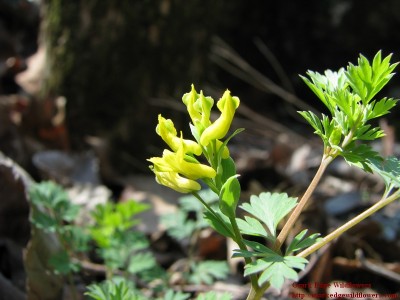 The ferny shaped leaves of Pale Corydalis can be mistaken for Dutchman’s breeches, but the flower is quite different
The ferny shaped leaves of Pale Corydalis can be mistaken for Dutchman’s breeches, but the flower is quite different
Habitat- Dicentra cucullaria is usually found in moist woods at the base of slopes. On Ozarkedge, I’ve noticed them most on north and west facing slope. I’m not sure if that is common elsewhere. Here, they are seen in rocky areas and not too far from water. Dutchman’s Breeches love company and tend to grow in colonies.
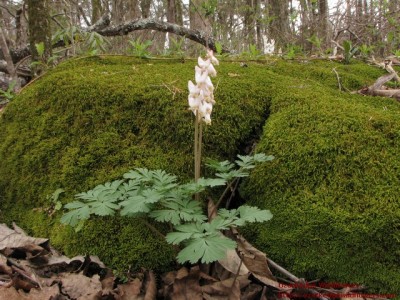 Growing between two moss covered stones
Growing between two moss covered stones
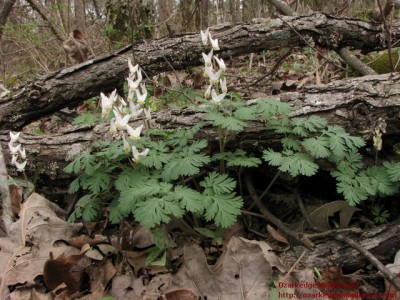
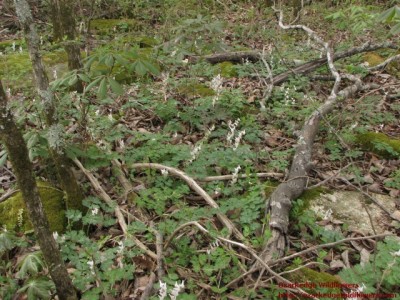 Colony of Dicentra cucullaria in rich woodland habitat
Colony of Dicentra cucullaria in rich woodland habitat
Propagation- Please don’t dig the wild plants. You can purchase them from a reputable nursery or save seed from the plant. I haven’t tried planting the seed and in one reference find that it should be planted as soon as it is ripe, but in another find that it should not be planted until the next fall. Obviously, I need more research or just need to try for myself. It will take a few years for the seedling to grow into a plant mature enough to bloom. If you have plants in your garden, you can divide the bulbs. It will still take more than a year for the divided bulblet to produce a plant large enough to bloom. Here’s a picture of the seed pods.
What’s Growing Nearby- I’m always interested in what’s growing nearby when I try to find plants in the wild. At Ozarkedge, I find Dutchman’s Breeches growing in rocky woods alongside Bloodroot, Trillium and Trout Lilies. Pale Corydalis and Cardamine Douglassi are also found nearby.
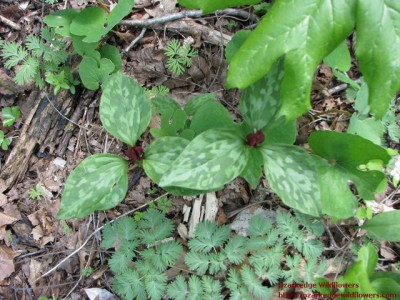 Notice the leaves of Dutchman’s breeches among Purple trillium, Bloodroot and Mayapple
Notice the leaves of Dutchman’s breeches among Purple trillium, Bloodroot and Mayapple
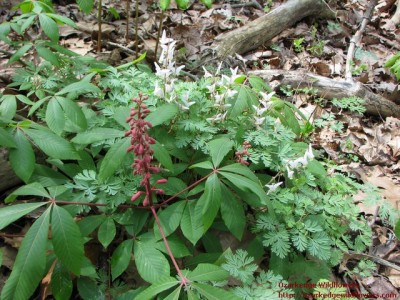 Dutchman’s breeches in bloom simultaneously with Red Buckeye (Aesculus pavia)
Dutchman’s breeches in bloom simultaneously with Red Buckeye (Aesculus pavia)
Endangered List- Although you can look up Dicentra cucullaria on the USDA Plant Site, it doesn’t show the Legal Status (which is the tab where the Conservation Status per state is shown).
Natureserve Unfortunately, our lovely Dutchman’s breeches are Critically Imperiled in North Dakota, Mississippi and South Carolina. It’s found to be Imperiled in Oklahoma and Alabama and Vulnerable in Georgia. Four states list it as Secure– Iowa, Kentucky, West Virginia and Virginia. North Caroline lists it as Apparently Secure. It’s Unranked in all other states within its range.
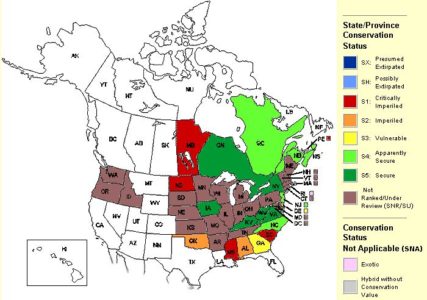
*NatureServe. 2018. NatureServe Explorer: An online encyclopedia of life [web application]. Version 7.1. NatureServe, Arlington, Virginia. Available http://explorer.natureserve.org. (Accessed: March 9, 2019 ).
Interesting Tidbits- All members of the Dicentra family are poisonous and can cause skin rashes. Cattle can suffer convulsions or death if they consume too many leaves—but at Ozarkedge, this would not be too much of a problem as the plant tends to grow where the cattle would not prefer to venture.